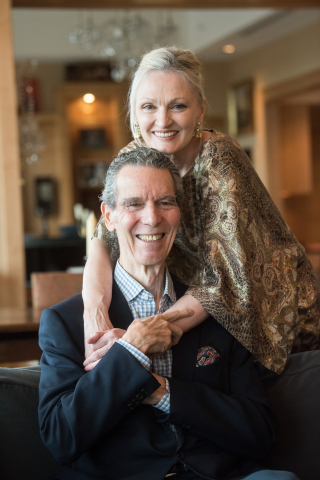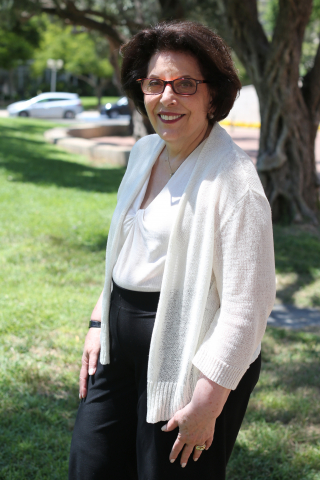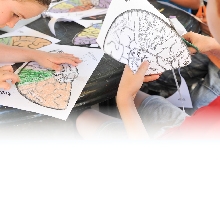Living and breathing science
Establishing the Pennie and Gary Abramson Family International Residence
People behind the science

For Pennie and Gary Abramson, a decades-long relationship with the Weizmann Institute of Science and its scientists has led to a deep understanding of the importance of investing in the next generation of scientific leaders—bright young minds, who, says Pennie, “are the source of creative new ideas and new energy that they infuse into research.” It is that concept that underlies the couple’s recent decision to make the lead gift that will name a new 120-unit, 16-floor residence hall for students and postdoctoral fellows: the Pennie and Gary Abramson Family International Residence.
The gift for the new dormitory building was a reflection of the Abramsons’ long history of leadership with the American Committee, where Pennie previously served as President and she and Gary held a series of other leadership roles. The building is a fundraising project of the American Committee and its friends across the US; other American donors have generously supported the project, including Richard and Mica Hadar of Boston, Ellen Merlo and the Pearl Welinsky Merlo Foundation of New York, Ted and David Teplow and family of Boston. Among other endeavors, the Abramsons are responsible for having expanded Weizmann’s circle of friends in the Washington D.C. area, as co-chairs of the mid-Atlantic region. They are both members of the International Board, and Pennie received a PhD honoris causa from the Institute in 2010. They are highly philanthropic across many causes in the arts and education, and Jewish organizations.
Just as importantly, in making this gift, the Abramsons—who split their time between their homes in Potomac, Maryland, and Fisher Island, Florida—have also made a statement of their wish to ensure the ongoing connection between next generations of their family (three children and four grandchildren) with the Weizmann Institute. “We would be delighted if the connections that we made and the relationships that we built with Weizmann over the years would continue with our children and grandchildren,” says Pennie, “so that Weizmann is their anchor in Israel like it has been ours.”
A home away from home for international and Israeli students and postdocs, the residence will have pervasive impact across campus because its residents will work in labs across all five faculties and will therefore advance countless avenues of research. The Pennie and Gary Abramson Family International Residence, designed by Kimmel Eshkolot Architects, will be located steps away from the main campus gate and across from the Charles Clore International House, which also houses students and postdocs. Its close proximity to the Institute will afford its residents easy access to their labs and precluding the burden of shopping for living spaces in an increasingly expensive local housing market.
Collaboration central
“Science is an international endeavor, so the campus of a scientific research institution like the Weizmann Institute of Science must enable interaction across labs and buildings—and also living spaces,” says Weizmann Institute President Prof. Alon Chen. “A core principle of the Pennie and Gary Abramson Family International Residence is interaction and it is truly fitting that two leaders who value human interaction and connection like Pennie and Gary have taken a lead on this project.”
The lack of restrictive borders between faculty and departments, and the emphasis on the cross-fertilization of ideas, are central Weizmann tenets, and the Institute plans everything from building design, green spaces, and access to conference spaces accordingly. “Our thinking and planning always revolves around the essential hallmark of interaction,” says Prof. Chen. “Interaction isn’t just ‘nice to have’ but in fact is essential if we want to make new breakthroughs that will make a revolutionary difference. It is our task to lay the groundwork for students and postdocs to create networks and friendships with one another, which inevitably evolve into scientific collaborations, ultimately enriching science.”
Prof. Gilad Perez, Dean of the Feinberg Graduate School, says, “The networking process begins here on campus over coffee and meals and informal conversations, and continues in labs. So, offering a space where tomorrow’s scientific leaders can live in comfort in an aesthetic environment is highly important, so they have the peace of mind and inspiration to do what they came here to do: study and train and contribute to scientific research. Then, when [these individuals] go out into the world and establish their careers, they naturally continue those partnerships. They also become the best possible ‘Weizmann ambassadors’ that we could hope for.”
In 2009, Pennie and Gary spearheaded the establishment of the Abramson family endowed fund at Weizmann to support newly hired scientists—young principal investigators who arrive fresh from postdoctoral fellowships abroad, and who are beginning to map out their research plans and put their creative ideas into motion.
Prof. Maya Schuldiner is among the scientists who benefitted from the Abramson Family Center for New Scientists. “Pennie and Gary are remarkable people in that they deeply care about science, and most importantly the scientists themselves and how they can shape the future of our planet,” she says. “But the main attribute that makes them so special to me is that they always have a warm place in their heart for the people around them. This creates a special connection. Even our children look forward to their yearly visits to Israel during the Board meetings.”
And while advancing Israeli science is an obvious reason for supporting Weizmann and underlies their giving, their connection to Weizmann has been grounded, says Gary, “first and foremost in the people we came to know throughout the years: the scientists, the leadership, other supporters, and even their children and family members. From our local circle in Washington to Rehovot and the entire ‘world of Weizmann’—this is our extended family.”
“The faculty members I met years ago, like (Profs.) Yadin Dudai, and Avigdor Scherz, and Varda Rotter, and others became our friends, and we used to host a dinner for the scientists in Israel before the International Board, and they became like family,” says Pennie. “Weizmann has always had a personal touch, and that has made all the difference in the world for us.”
In designing the new building, the architects integrated green-building design principles including energy efficiency measures to reduce heating and cooling insulation, and take advantage of daylight.
For Gary, whose life’s work is in real estate, naming a building that will reflect similar values to those he and his family have pursued throughout his career—creating comfortable, aesthetically pleasing, modern spaces that enable vibrant interaction and progress—was “an ideal statement for us about building a strong future.” Gary’s firm, Tower Companies, is a leading real estate development company in the Washington D.C. area and the largest builder of LEED®-certified green building properties—and one of the pioneers of sustainable building practices in the U.S.
“The concept of this amazing new building—everything about it from how it was designed and what it was designed for, and the impact it will have on the research—spoke to us,” says Pennie. “We feel that it is an unequivocal investment in the future of science, and it solidifies our family anchor in Israel.”
Vibrant communal spaces
The penthouse floor
Architectural plans for the Pennie and Gary Abramson Family International Residence call for a lobby surrounded by a series of breakout rooms for working and meeting, a small library, and a common kitchen. The penthouse floor, which includes a clubhouse lounge, a rooftop terrace overlooking campus, and other communal spaces, will be named for Richard and Mica Hadar, recognizing their visionary gift that will offer others a literal vision: a sweeping vista of campus and the surrounding area.
A real estate investor and entrepreneur, Richard saw in the new residence hall “an investment in the future of science, and the future of the people who will inhabit this building.” Mica, an actress, artist, and writer who was born and raised in Italy, says she was drawn to its mission and aesthetics and knew it would be “a beautiful spot for people to interact and collaborate.”
The couple split their time between their new home in Boston—after decades in New York—and their home in Chianti, Italy. In addition to Weizmann, their foundation gives to a range of causes in education, art, and culture. Richard and Mica have supported college scholarships for underprivileged students across the U.S. for decades, which they say reflects their interest in using higher education as a lever to advance individuals and the fields they choose to pursue. Richard himself had a middle-class upbringing in New Jersey and rural Pennsylvania, and went on to fund his college education through ROTC, the college-based army officer training program. He then served in the U.S. Army.
Mica attended the prestigious Italian acting school Bottega Teatrale in Florence, and was a protégé of its founder, Vittorio Gassman. She went onto a successful career that has included more than 25 off-Broadway productions, and today she writes plays and is engaged in a variety of artistic endeavors.
Both of their educational opportunities, they say, were instrumental in launching their careers, which underlies their support for college students with career aspirations in both the arts and the sciences. In this way, their foundation has put hundreds of students through college and has also provided them with mentoring and professional guidance, as well as a lifelong network of support. Many Hadar Scholars go on to earn masters and doctoral degrees.
Their most recent gift to the Weizmann Institute, which names the penthouse floor of the new Pennie and Gary Abramson Family International Residence, says Richard, “supports students, and in this case with major global impact, because these students and postdocs are from all over the world, and science is global.”
Richard and Mica were first introduced to the Weizmann Institute at a gala dinner at the Waldorf Astoria in New York about two decades ago—a dinner that, with its panel of Weizmann scientists and Nobel Prize winners—ignited interest in many individuals who are Weizmann supporters today. It was at that event that they decided to expand their philanthropy to create a global impact, and Weizmann became their main international beneficiary.
At their home in New York, they hosted gatherings of Feinberg Graduate School students and American Committee friends for informal science talks, and their annual support has touched many areas across campus. Their Hadar Impact Fund supports a range of research avenues on campus, from protein design to overcome antibiotic resistance, to stem cells, neuroscience, and more. They were inducted into the President’s Circle at the Global Gathering in Boston in 2018.
“One of the things that continues to impress us about Weizmann is how the scientists and students interact by living near each other and so they are in a continuous conversation with one another both in off-hours and during working hours,” says Richard. Says Mica: “This cross-pollination and exchange is a secret to Weizmann’s success, and we were wowed by it when we first came to campus in 2005 and in our other visits. It was a real eye-opener.”
The lobby, in honor of Pearl Welinsky Merlo
Expected to be a hub of activity, the lobby in the Pennie and Gary Abramson Family International Residence will be named for Pearl Welinsky Merlo, the late mother of Ellen Merlo, whose philanthropic foundation also bears her mother’s name. Ellen is a member of the International Board and past Chair of the American Committee who gave the first gift to kick off the residence hall’s fundraising campaign several years ago. She received a PhD honoris causa from the Weizmann Institute in 2018.
Deeply devoted to advancing women in science in particular and leader of ACWIS’ Women for Science program, she has been involved both professionally—as a former top executive at Philip Morris—and philanthropically in a range of women’s causes. At Phillip Morris, she spearheaded the Virginia Slims women’s tennis tour, helping to infuse funds into the tour and thereby bring prize money on par with that of the men’s pro tour.
Ellen’s mother was one of 12 siblings, 8 of whom perished in the Holocaust. Ellen grew up in the shadow of her mother’s grief—and, also, inspired by her mother’s constant care and concern for Israel which, to Pearl Welinsky Merlo, was a beacon of hope after the tragedy that befell the Jewish people. “Israel meant everything to my mother,” says Ellen. “After the war, and for the rest of her life, she worried about ‘my little Israel’—that’s what she called it. She couldn’t have been prouder that I got involved in Israel and then when I got involved with Weizmann, it was so meaningful to her—the science, the future, what it was doing for the State of Israel. And to know that her name will be there in this new building on campus means everything to me—and would have meant everything to her.”
Students and postdocs by the numbers
422 MSc students, including 45 international
757 PhD students, including 139 international
462 Postdoctoral fellows, including 300 international
—Tamar Morad

Rendering of the Pennie and Gary Abramson Family International Residence

Mica and Richard Hadar

Ellen Merlo







